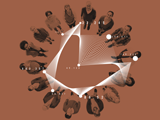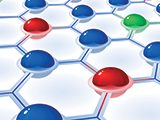IMDEA Networks

Archivos: Events
IPv4 Address Space Exhaustion: Where Are We Now?
The Internet faces a fundamental resource shortage problem: We have run out of freely available IPv4 address space. Today, four out of five of the registries serving the global demand for IPv4 address space have exhausted their address reserves. Networks in need of IPv4 address space can no longer get more address allocations from their respective registries.
Seguir leyendo arrow_right_altEricsson presenta en 5TONIC demo de tecnología desarrollada dentro del proyecto 5G-Crosshaul
Se hará una demostración de avances tecnológicos logrados por el proyecto 5G-Crosshaul a representantes de Telefónica el 4 de octubre de 2016, en el Instituto IMDEA Networks.
Seguir leyendo arrow_right_altNetwork Geometry: Theory and Applications
The lack of predictive power over complex systems either designed by humans or evolved by nature, is a foundational problem in contemporary science. Real networks such as the Internet, the Web, social and biological networks, have acquired emergent large-scale properties that are beyond our full understanding, much less prediction or control. Astonishingly, these emergent properties are the same across networks from drastically different domains, and are the ones required to facilitate the optimality of some important network functions, such as information transport.
Seguir leyendo arrow_right_altBayesian jamming games and queues
We discuss some applications of Bayesian games to interesting networking scenarios.
Seguir leyendo arrow_right_altDefensa Tesis Doctoral: Optimization of Energy Efficiency in Data and Web Hosting Centers
This thesis tackles the optimization of energy efficiency in data centers in terms of network and server utilization.
Seguir leyendo arrow_right_altDefensa Tesis Doctoral: Enhancing Wireless local area Networks by leveraging Diverse Frequency Resources
In this thesis, signal propagation variations that are experience over the frequency resources of IEEE 802.11 Wireless Local Area Networks (WLANs) are studied.
Seguir leyendo arrow_right_alt5TONIC @ South Summit 2016
El laboratorio de investigación y de innovación abierta 5TONIC participa en el evento South Summit 2016, que tiene lugar los días 5-7 de octubre de 2016, en Madrid (España).
Seguir leyendo arrow_right_altAdopting Software-Defined Networking: Challenges and Recent Developments
Traditional network management only allows to deploy a predefined set of management policies whose parameters can be adapted to specific...
Seguir leyendo arrow_right_altLow Delay Random Linear Coding and Scheduling Over Multiple Interfaces
Multipath transport protocols like MPTCP transfer data across multiple routes in parallel and deliver it in order at the receiver. When the delay on one or more of the paths is variable, as is commonly the case, out of order arrivals are frequent and head of line blocking leads to high latency. This is exacerbated when packet loss, which is also common with wireless links, is tackled using ARQ.
Seguir leyendo arrow_right_altFIB Efficiency in Distributed Platforms
The Internet routing ecosystem is facing substantial scalability challenges due to continuous, significant growth of the state represented in the data plane.
Seguir leyendo arrow_right_alt











Comentarios recientes